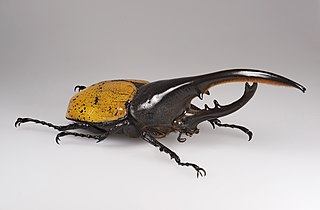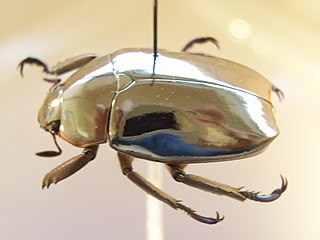
The family Scarabaeidae, as currently defined, consists of over 30,000 species of beetles worldwide; they are often called scarabs or scarab beetles. The classification of this family has undergone significant change in recent years. Several subfamilies have been elevated to family rank, and some reduced to lower ranks. The subfamilies listed in this article are in accordance with those in Bouchard (2011).

An elytron is a modified, hardened forewing of beetles (Coleoptera), though a few of the true bugs (Hemiptera) such as the family Schizopteridae are extremely similar; in true bugs, the forewings are called hemelytra, and in most species only the basal half is thickened while the apex is membranous, but when they are entirely thickened the condition is referred to as "coleopteroid". An elytron is sometimes also referred to as a shard.

Dung beetles are beetles that feed on feces. Some species of dung beetles can bury dung 250 times their own mass in one night.

Glaresis is a genus of beetles, sometimes called "Enigmatic scarab beetles", in its own family, the Glaresidae. It is closely related to, and was formerly included in, the family Scarabaeidae. Although its members occur in arid and sandy areas worldwide, only the nocturnal adults have ever been collected, and both the larvae and biology of Glaresis are as yet unknown. Due to their narrow habitat associations, a great number of these species occur in extremely limited geographic areas, and are accordingly imperiled by habitat destruction.

Scarabaeoidea is a superfamily of beetles, the only subgroup of the infraorder Scarabaeiformia. Around 35,000 species are placed in this superfamily and some 200 new species are described each year. Its constituent families are also undergoing revision presently, and the family list below is only preliminary. This superfamily includes some of the largest beetles extant today, including rhinoceros beetles, (Dynastinae), the Hercules beetle and Goliath beetles.

The Hercules beetle is a species of rhinoceros beetle native to the rainforests of Central America, South America, and the Lesser Antilles. It is the longest extant species of beetle in the world, and is also one of the largest flying insects in the world.

Dynastinae or rhinoceros beetles are a subfamily of the scarab beetle family (Scarabaeidae). Other common names – some for particular groups of rhinoceros beetles – include Hercules beetles, unicorn beetles or horn beetles. Over 1500 species and 225 genera of rhinoceros beetles are known.

Allomyrina dichotoma, also known as Japanese rhinoceros beetle, Japanese horned beetle, or kabutomushi, is a species of rhinoceros beetle.

The rain beetles are a group of beetles whose extant species are found only in the far west of North America. They spend most of their lives underground, emerging in response to rain or snow, thus the common name. Formerly classified in the Scarabaeidae, they are currently assigned to their own family Pleocomidae, considered the sister group to all the remaining families of Scarabaeoidea. The family contains a single extant genus, Pleocoma, and two extinct genera, Cretocoma, described in 2002 from Late Cretaceous deposits in Mongolia, and Proteroscarabeus of Late Cretaceous China.

The scarab beetle subfamily Scarabaeinae consists of species collectively called true dung beetles. Most of the beetles of this subfamily feed exclusively on dung. However, some may feed on decomposing matter including carrion, decaying fruits and fungi. Dung beetles can be placed into three structural guilds based on their method of dung processing namely rollers, dwellers and tunnelers Dung removal and burial by dung beetles result in ecological benefits such as soil aeration and fertilization; improved nutrient cycling and uptake by plants, increase in Pasture quality, biological control of pest flies and intestinal parasites and secondary seed dispersal. Well-known members include the genera Scarabaeus and Sisyphus, and Phanaeus vindex.

Aphodiinae is a subfamily of the scarab beetle family, Scarabaeidae. Members of this subfamily are known commonly as the small dung beetles and many, but not all, are dung beetles. These beetles are found worldwide.

Melolonthinae is a subfamily of the scarab beetles. It is a very diverse group; distributed over most of the world, it contains over 11,000 species in over 750 genera. Some authors include the scarab subfamilies Euchirinae and Pachypodinae as tribes in the Melolonthinae.
The American Elm cultivar Ulmus americana 'Flick's Spreader' was cloned from a tree discovered by John T. Flick on a farm near Hammon, Oklahoma. Cuttings were given to the Sunshine Nursery, Clinton, Oklahoma, in 1997, which later marketed the tree as 'Flick's Spreader'.

Ataenius is a genus of aphodiine dung beetles in the family Scarabaeidae. There are at least 290 described species in Ataenius.

Onthophagus is a genus of dung beetles in the Onthophagini tribe of the wider scarab beetle family, Scarabaeidae. It is the most species-rich and widespread genus in the subfamily Scarabaeinae, with a global distribution.

Xylotrupes gideon, the brown rhinoceros beetle, is a species of large scarab beetle belonging to the subfamily Dynastinae.

Monkey beetles are scarab beetles, a group of several genera within the tribe Hopliini. The placement of this tribe within the family Scarabaeidae is uncertain between Melolonthinae and Rutelinae. Many species visit flowers for pollen and nectar, or browse on the petals. The beetles are important pollinators of Aizoaceae and Asteraceae in grazed and ungrazed areas, as well as many others. They tend to favor flowers of white, yellow, pink, orange, and blue pigments. They also tend to favor flowers of symmetrical, abstract patterns Due to their pollination patterns, many plants were able to develop special features that attracted monkey beetles, such as the Iridaceae which now have bright colors and symmetrical, unique patterns.

Rutelinae or shining leaf chafers is a subfamily of the scarab beetles. It is a very diverse group; distributed over most of the world, it contains some 200 genera with over 4,000 described species in 7 tribes. Several taxa have yet to be described.A few recent classifications include the tribe Hopliini, but this is not generally accepted.
Rutelini is a tribe of shining leaf chafers in the family Scarabaeidae. There are about 14 genera and at least 40 described species in Rutelini.


















